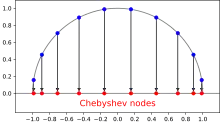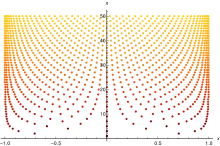Chebyshev nodes
In numerical analysis, Chebyshev nodes are specific real algebraic numbers, namely the roots of the Chebyshev polynomials of the first kind. They are often used as nodes in polynomial interpolation because the resulting interpolation polynomial minimizes the effect of Runge's phenomenon.[2]

Definition

For a given positive integer n the Chebyshev nodes in the interval (−1, 1) are
These are the roots of the Chebyshev polynomial of the first kind of degree n. For nodes over an arbitrary interval [a, b] an affine transformation can be used:
Approximation
The Chebyshev nodes are important in approximation theory because they form a particularly good set of nodes for polynomial interpolation. Given a function ƒ on the interval and points in that interval, the interpolation polynomial is that unique polynomial of degree at most which has value at each point . The interpolation error at is
for some (depending on x) in [−1, 1].[3] So it is logical to try to minimize
This product is a monic polynomial of degree n. It may be shown that the maximum absolute value (maximum norm) of any such polynomial is bounded from below by 21−n. This bound is attained by the scaled Chebyshev polynomials 21−n Tn, which are also monic. (Recall that |Tn(x)| ≤ 1 for x ∈ [−1, 1].[4]) Therefore, when the interpolation nodes xi are the roots of Tn, the error satisfies
For an arbitrary interval [a, b] a change of variable shows that
Notes
- Lloyd N. Trefethen, Approximation Theory and Approximation Practice (SIAM, 2012). Online: https://people.maths.ox.ac.uk/trefethen/ATAP/
- Fink, Kurtis D., and John H. Mathews. Numerical Methods using MATLAB. Upper Saddle River, NJ: Prentice Hall, 1999. 3rd ed. pp. 236-238.
- Stewart (1996), (20.3)
- Stewart (1996), Lecture 20, §14
References
Further reading
- Burden, Richard L.; Faires, J. Douglas: Numerical Analysis, 8th ed., pages 503–512, ISBN 0-534-39200-8.
